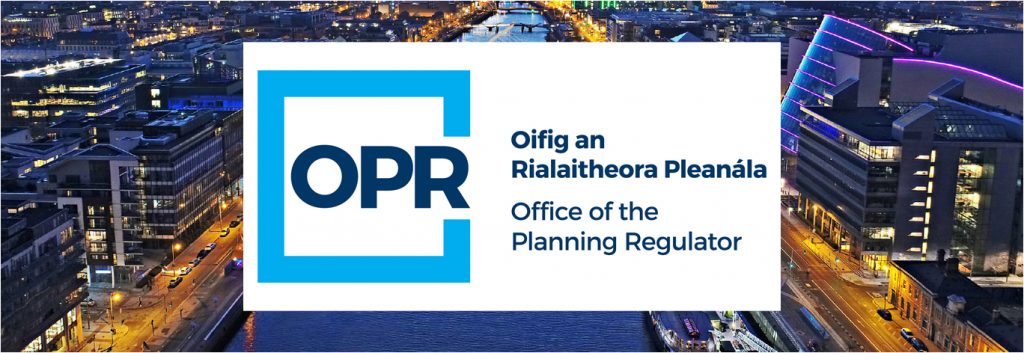Niall Cussen, Planning Regulator
Covid has changed much about our lives. It has changed how we work, how we socialise, even, at times, where we can go.
Suburbs (where people live) bustle, but city centres and high streets (where people work and shop) bumble.
Fewer cars and cleaner air mean roads and streets are safer for strolling. Striking is the vista of so many out for walks, cycles or just fresh air in both urban and rural areas, looking after their physical and mental health during lockdowns.
The pandemic and its restrictions emphasise to many the importance of your local community’s amenities and facilities. What can be accessed within 5km is a life-changer.
As we (hopefully) emerge from the worst effects of the pandemic, it’s most unlikely and probably undesirable that we just revert to the way things were. Lessons need to be learned.
Planning and Public Health
To someone working in the planning process for 30 years, our recent and still ongoing Covid crisis reaffirms – not reverses – good planning objectives and principles, derived over decades, centuries even, in the relationship between planning and public health.
Urban planning in these islands began as a Victorian era public health centred response to spread of diseases in overcrowded and poorly developed urban slums.
Cholera epidemics in the 19th century prompted modern sanitary systems and public housing programmes. Building regulations around light and air countered respiratory diseases in overcrowded slums. Parks and amenities were established to benefit people’s lives.
Governments and private benefactors like the Guinness family-backed Iveagh Trust knew and understood the link between good quality places and healthier communities.
In 2020, Covid has brought us back full circle. The future-now shock of Covid has reconnected us to the importance of the quality of our local places – be they urban or rural. Rooted to our local places, we are noticing more – sometimes wanting better in terms of the way we move about, access to amenities and facilities we now know we really need.
Emboldened by the clear need to act to save the vitality of de-workered city and town centres, lots of new initiatives have sprung up. Should these stay? Will they be enough?
Yes and no. Pre-covid, progressive local authorities were already working to provide better public infrastructure in their areas but the pandemic has stepped it all up. Footpaths widened. New cycle routes. Extended outdoor caf̩ and restaurant areas. Urban mini-parks Рall have sprung up to stir city and town centres on life-support.
Public parks and amenities, play areas, canal towpaths have witnessed marked growth in usage throughout Covid. We appreciate more than ever how our green spaces allow us to reconnect with nature and there are lessons there for future planning.
Huge efforts by local authorities
Our local authorities have made a huge effort in dealing with the pandemic. Those that continue to facilitate more active travel alternatives and put green and nature-based thinking at the heart of their planning will be the ones that create much more resilient and adaptable communities for their citizens. These communities will be the ones to rebound quickest.
Covid has also prompted commentary around our approach to housing. An exodus from cities to a rural e-working alternative – even idyll – is seen by some as the answer.
But we faced an existential challenge long before Covid – climate change – and once the wretched disease is under control, climate action will continue to drive a need to change Ireland’s traditional focus on building our cities, towns and villages outwards, often leaving town and city centres behind.
An oft-heard and knee-jerk reaction is: lets spread people out more, build at even lower than the very low densities we build at in this country, build even more of our housing in the countryside, sure can’t we all e-work?.
But where will that bring us? Remote working does offer new ways to reduce lengthy and unproductive commutes to e-retrofit already sprawled suburbs. E-working hubs are a game-changer in reviving rural towns and villages. But meeting most of our housing into the future in the countryside? Seriously? That would be a hugely energy intensive way of living, with people more disconnected from the communities we’ve come to value more.
Instead, others champion newer, smarter ways. Dublin Chamber has promoted its 15 minute City concept and the Southern Regional Assembly its 10 Minute Town Framework and Methodology. These initiatives are about a more imaginative mixed use approach to the planning of our cities and towns coupled to a radical transformation of our streets through integrated mixes of active travel and public transport, where anything you need is literally no more than 10 or 15 minutes away and you feel a part of a community, not just a commuter.
What should fill our city and town centres of the future?
And that brings us to the big planning question on the response to places permanently affected if not all the office workers return to city and town centres and the shift to on-line retail continues. What should fill our city and town centres of the future?
The answer: another circle turning fully – city and town centres full of people that live there, work there and enjoy all the amenities and cultural vitality that people through the ages have enjoyed in properly planned urban locations. Like the ones we used to visit on holidays.
Good planning is going to be the difference in adapting cities and towns facilitating greater residential development that is of high quality and fundamentally affordable to replace the almost total reliance on office and retail no longer in such demand.
Last year, according to CSO statistics, the town of Naas in County Kildare, saw just about the same number of new homes built as in all of Dublin 1-8 combined. Most of our regional cities are likewise – greenfield trumps brownfield every time.
Isn’t that a wake-up call to authorities, communities and property owners alike to rethink what we prioritise in our city and town centres? As the National Planning Framework highlights, vibrant cities and towns will come about through proactive and publicly directed housing rather than a sole reliance on market forces.
The smart development money will be on schemes that provide a superb mix of living and working and leisure and the smart property owner will be looking afresh at those empty upper – even ground floors and asking their local authority how to turn the lights on!
Homes are working harder
The physical layout of our homes also needs some fresh thinking. The point has been well-made in recent months that, for many, our homes are working harder than ever before. Part office, lecture hall, classroom and necessary provider of both personal yet flexible spaces.
And living and working in a home over a longer period brings energy efficiency into much sharper focus. With heater settings in older homes pressed into 24-hour service rather than the more usual morning and evening toasting, how many are thinking hard about retro-fitting. SEAI grant schemes will be busy!
The basic point being made here is that there were many trends and issues present pre-Covid that our response to the pandemic – and maybe even future pandemics – must continue to learn from and act on. We must re-connect to planning objectives just as relevant today.
For the Office of the Planning Regulator, our independent assessments of local authority development plans, dozens of which are due for review in the next 12-18 months, our research and planning authority reviews programs, all reachable at www.opr.ie are going to be the real litmus test in whether we have all learned from the pandemic and reconnected to those old but still true planning objectives.


